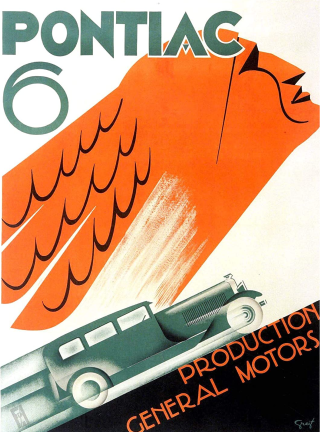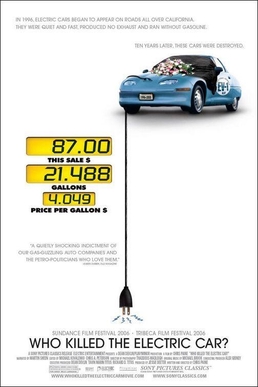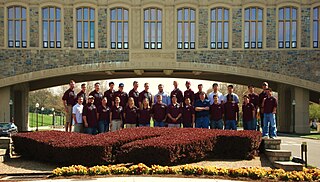Related Research Articles

General Motors (GM), formally the General Motors Company, is an American multinational automotive manufacturing company headquartered in Detroit, Michigan, United States. By sales, it was the largest automaker in the United States in 2022, and was the largest in the world for 77 years before losing the top spot to Toyota in 2008.

The automotive industry comprises a wide range of companies and organizations involved in the design, development, manufacturing, marketing, selling, repairing, and modification of motor vehicles. It is one of the world's largest industries by revenue. It is also the industry with the highest spending on research & development per firm.

A car platform is a shared set of common design, engineering, and production efforts, as well as major components, over a number of outwardly distinct models and even types of cars, often from different, but somewhat related, marques. It is practiced in the automotive industry to reduce the costs associated with the development of products by basing those products on a smaller number of platforms. This further allows companies to create distinct models from a design perspective on similar underpinnings. A car platform is not to be confused with a platform chassis, although such a chassis can be part of an automobile’s design platform, as noted below.

The Partnership for a New Generation of Vehicles was a co-operative research program between the US government and the three major domestic auto corporations that was aimed at bringing extremely fuel-efficient (up to 80 mpg‑US vehicles to market by 2003.

Who Killed the Electric Car? is a 2006 American documentary film directed by Chris Paine that explores the creation, limited commercialization and subsequent destruction of the battery electric vehicle in the United States, specifically the General Motors EV1 of the mid-1990s. The film explores the roles of automobile manufacturers, the oil industry, the federal government of the United States, the California government, batteries, hydrogen vehicles and consumers in limiting the development and adoption of this technology.
GM Defense is the military product subsidiary of General Motors headquartered in Concord, North Carolina; focusing on the defense industry needs with hydrogen fuel cell and other advanced mobility technologies. GM Defense projects include SURUS an autonomous modular platform joint project with the United States Army.

The Hybrid Electric Vehicle Team of Virginia Tech, better known as HEVT, is a nationally recognized undergraduate student design team in the Department of Mechanical Engineering at Virginia Tech. HEVT was formed in 1994 to compete in the 1995 Hybrid Electric Vehicle (HEV) Challenge, one of the many competitions organized by the Argonne National Laboratory through the United States Department of Energy. HEVT has been involved in the Department of Energy Advanced Vehicle Technology Competitions (AVTCs) ever since. HEVT attributes a significant amount of its success to their Advisor, Professor Doug Nelson in Mechanical Engineering. Dr. Nelson has received the Outstanding Faculty Advisor award at competition 3 times. He has greatly aided the education of students at Virginia Tech and helped the team succeed at competition The overall highlights of past competitions are as follows:
United States Council for Automotive Research LLC (USCAR) is an umbrella organization for collaborative research that comprises Ford Motor Company, General Motors and Stellantis. Its goal is to further strengthen the technology base of the U.S. auto industry through cooperative research and development. It has Electrical Wiring Component Applications Partnership, United States Automotive Materials Partnership, and United States Advanced Battery Consortium (USABC) as part of its consortia. USABC pursues research and development of advanced energy systems for electric and hybrid electric vehicles to achieve significantly increased range and performance.
The United States Army DEVCOM Ground Vehicle Systems Center (GVSC) (formerly United States Army Tank Automotive Research, Development and Engineering Center (TARDEC)), located in Warren, Michigan, is the United States Armed Forces' research and development facility for advanced technology in ground systems. It is part of the U.S. Army Combat Capabilities Development Command (DEVCOM), a major subordinate command of the U.S. Army Futures Command. GVSC shares its facilities with the United States Army Tank-automotive and Armaments Command (TACOM). Current technology focus areas include Ground Vehicle Power and Mobility (GVPM), Ground System Survivability and Force Protection, among others.
EcoCAR: The NeXt Challenge was a yearly competition from 2008 to 2011, that built on the 19-year history of U.S. Department of Energy (DOE) advanced vehicle technology competitions by giving engineering students the chance to design and build advanced vehicles to demonstrate cutting-edge automotive technologies, with the goal of minimizing the environmental impact of future personal transportation. The DOE has again joined General Motors (GM), the Government of Canada, and other sponsors for this new competition series, named the EcoCAR Challenge. Argonne National Laboratory, a DOE research and development facility, will organize and operate the EcoCAR Challenge. Some previous types of advanced vehicle technology competitions include FutureTruck, FutureCar, and Challenge X. these type of competitions are usually supported by one or more of the Big Three American Automobile Manufacturers.

The Personal Urban Mobility and Accessibility (PUMA) was an experimental electrically powered road vehicle created by Segway and adopted by General Motors as a concept vehicle representing the future of urban transportation. It operates on two wheels placed side by side, a layout that differs in placement from motorcycles which instead have their two wheels placed at the front and rear.
Honda Advanced Technology is part of Honda's long-standing research and development program focused on building new models for their automotive products and automotive-related technologies, with many of the advances pertaining to engine technology. Honda's research has led to practical solutions ranging from fuel-efficient vehicles and engines, to more sophisticated applications such as the humanoid robot, ASIMO, and the Honda HA-420 Honda-jet, a six-passenger business jet.
Gary W. Dickinson was an automotive industry executive.

Bright Automotive was a startup company in Anderson, Indiana, working to create a fuel-efficient line of plug-in electric vehicles. The company was started in 2008 with a team of employees from former companies such as Chrysler, Delphi, GM, Mazda, and Toyota. The company designed its first vehicle, the IDEA, a plug-in hybrid electric fleet vehicle designed to reduce fuel costs for corporations that maintain a large commercial fleet. Bright also had a service branch called eSolutions that focused on speeding up the process of car electrification with consulting and conversions. Bright's last CEO, Reuben Munger, stated in early press releases that he wished to see the IDEA in production by 2013.
A connected car is a car that can communicate bidirectionally with other systems outside of the car (LAN). This allows the car to share internet access, and hence data, with other devices both inside and outside the vehicle. For safety-critical applications, it is anticipated that cars will also be connected using dedicated short-range communications (DSRC) or cellular radios, operating in the FCC-granted 5.9 GHz band with very low latency.
The University of Kansas Sustainable Automotive Energy Infrastructure Initiative, or more commonly referred to as the KU Ecohawks is an ongoing project that works to promote sustainability in the automotive sector. Founded during the beginning of the Automotive industry crisis of 2008–2010 in the U.S., the group recycles old vehicles to run on community wastes and renewables, especially on the University of Kansas campus and not rely on conventional fossil fuel sources that pollute the local and global environment.

The Alliance for Automotive Innovation is a Washington, D.C.-based trade association and lobby group whose members include international automobile and light duty truck manufacturers that build and sell products in the United States. In 2019, the Global Automakers merged with the Alliance of Automobile Manufacturers and became the Alliance for Automotive Innovation.
Advanced vehicle technology competitions (AVTCs) are competitions sponsored by the United States Department of Energy, in partnership with private industry and universities, which stimulates "the development of advanced propulsion and alternative fuel technologies and provide the training ground for the next generation of automotive engineers."

Zytek Automotive is a British powertrain and vehicle engineering specialist, which has been part of Continental AG since 2014. Zytek Automotive designs, develops, and integrates electric motors into a range of cars and commercial vehicles. The UK facility can accommodate up to 6,000 E-Drive integrations a year in batches as low as 100.
References
- ↑ GM: Senior Leadership Archived 2009-01-22 at the Wayback Machine Retrieved on 7 February 2009
- ↑ https://www.mlive.com/auto/2009/07/larry_burns_gms_research_and_d.html Larry Burns, GM's research and development chief, to retire
- ↑ TED: Larry Burns Retrieved on 7 February 2009
- ↑ "Larry Burns Elected to the National Academy of Engineering". 10 November 2011.
- ↑ "Larry Burns - Keynote Speaker Fees & Bio - GDA Speakers" . Retrieved 2018-08-06.